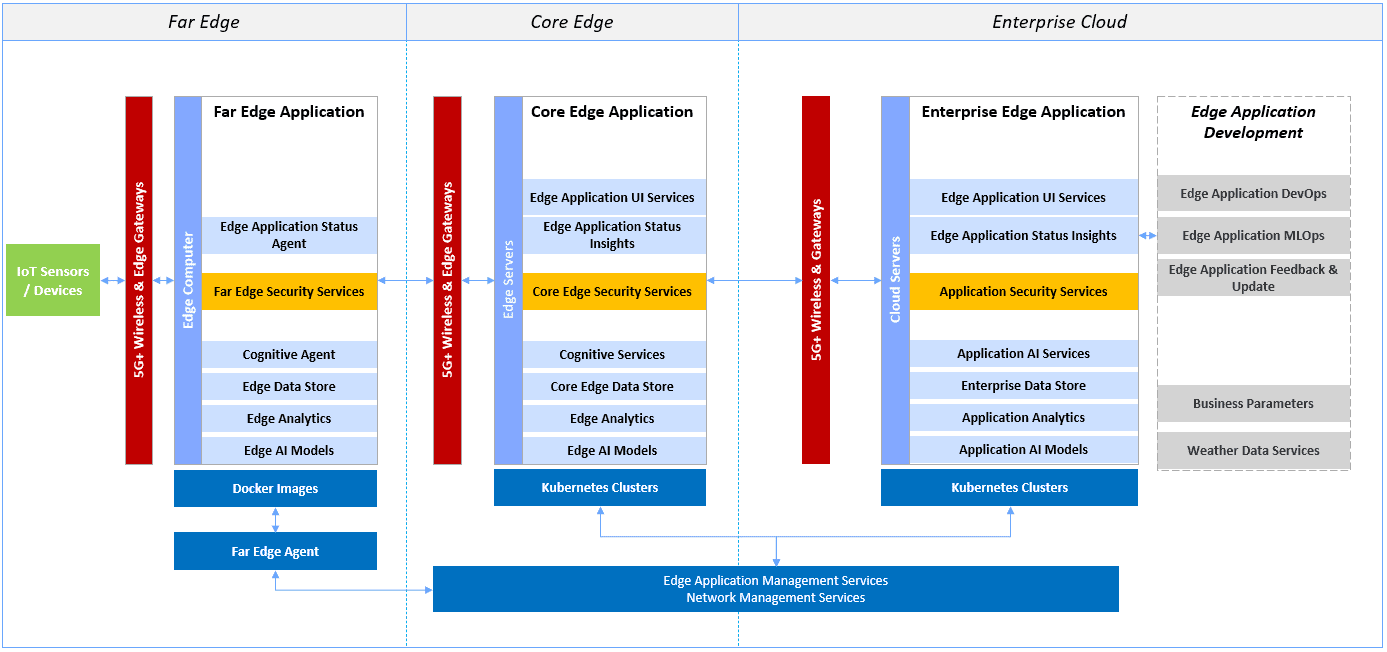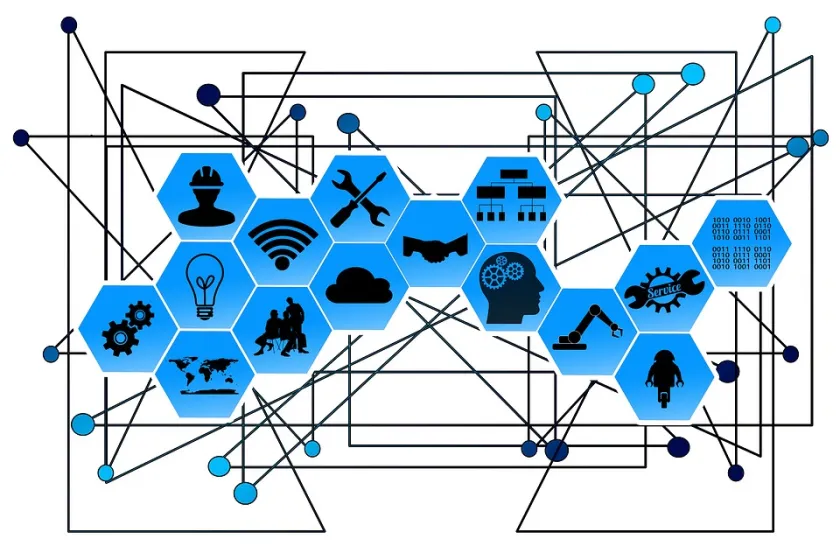Edge computing de-centralizes enterprise applications and processes data closer to its source. This cuts the need to transfer large amount of data through networks and resolves the low latency-bandwidth issue. While it is very challenging and at times infeasible to connect thousands of IoT sensors through wired network, 5G+ wireless with 10 Gbps of bandwidth and 10 ms of latency, supports up to 1 million sensors in a square mile.
Source: Architecting 5G+ Edge Application Featured
Telco’s are investing heavily on 5G+ offerings such as multi-access-edge, mobile edge computing, and expanding their network infrastructure over remote geographical locations to enable edge applications across all the industries. 5G+ enabled micro-cloud-edge applications are promising to be very efficient and more practical.
Edge Computing Architecture
Edge applications are very complex. They require thorough understanding of the business purpose and a solid architecture for a successful implementation. Stability, Scalability, and Security are the key aspects of an edge application underpinned by its architecture.

Figure 1: Key aspects of edge application underpinned by its architecture
Stability: Compared to traditional enterprise application that work on data warehouse, edge application processes live streams of data from thousands of IoT sensors connected to physical equipment located in remote industrial facilities. Multi-vendor hardware, software and distributed services must be integrated seamlessly to perform in perfect tandem. An unstable edge application may cause damage to business instead of bringing value. Some edge architectures factor redundancy to achieve stability but that application becomes too expensive to implement and manage. The modern DevOps method addresses the complexities in developing and managing stable edge applications.
Scalability: Although edge systems are evolving to be very powerful, they do not match the high-performance computing capabilities of cloud datacenters. Edge applications demand efficient computing resources at scale to process high velocity-volume data from thousands of IoT sensors. The edge application services must be distributed and scalable. Containerized microservices architecture can scale thousands of instances quickly and reliably when deployed using Kubernetes clusters under hybrid cloud environment.
Security: Security stays as the top concern for business and IT leaders. Security tools are well advanced but the recent trend in sophisticated ransomware attacks on business-critical applications are alarming. Edge applications have few points of “security vulnerability” since they transfer sensitive data outside of controlled environment and handle hundreds of IoT devices in remote locations through multiple layers of interfaces. In addition, experts have raised security concerns in 5G+ network that Telco’s are addressing through IMSI encryption, SDN, MG 3GPP, and NFV. Hardware and software vendors are including security as an integral part of their edge products. It is critical to define security as a key aspect of the architecture across all the layers of edge applications. Quantum-safe encryption promises highest level of protection for data and network in the future.
Reference Architecture for 5G+ Edge Application
Architecture underpins the performance and outcome of edge applications. The following key elements should be considered while defining the architecture of 5G+ edge application:
- Edge-centric hardware, software, and 5G+ wireless.
- Smart IoT sensors generate key operating parameters from thousands of machines.
- Kubernetes clusters to manage containerized microservices and handle workload at scale.
- AI models to derive insights and deliver actions at the edge.
- Modern DevOps and MLOps methods to efficiently develop and manage.
- APP Remote Control: Easily control your home...
- Voice Control: Smart plugs that work with Google...
- Easy Setup: It takes less than two minutes for the...
- Other Features: Diverse timer scheduling...
- 7*24 Customer Service: If you encounter any issues...
- BETTER INSIDE AND OUT – Entertainment is more...
- VIBRANT SIGHTS, FULL SOUND – Content on Prime...
- SMART HOME, SIMPLIFIED – Pair and control...
- STAY IN THE LOOP – Video call hands-free using...
- SHOW OFF YOUR GOOD TIMES – Amazon Photos turns...
Last update on 2024-04-05 / Affiliate links / Images from Amazon Product Advertising API
The reference architecture of 5G+ edge application has three layers: far edge, core edge, and enterprise cloud. The three-layer framework supports complex edge applications on distributed systems to run at scale, stable and secure. The Enterprise Edge Applications at the enterprise cloud consists of services to handle data store, analytics, AI models, network, security, and application management. Functionalities are delegated to the Far & Core Edge services. For example, Far Edge Analytics services process data from sensors and perform real-time analytics at the edge. Agents are lightweight services to interface with Core Edge and Edge Application Management (EAM). Core Edge services act as regional control center to manage few far edge services and coordinate actions to be executed.

Figure 2: Reference architecture for 5G+ edge application
The application services developed using Microservices framework are deployed on Kubernetes clusters at the Far Edge and Core Edge. The distributed services across the three layers depend on solid interfaces and coordination to deliver the performance and outcome. At runtime, the EAM handles Kubernetes cluster management, and network services management to provide the application reliability. Application UI services deliver monitoring dashboards on web and mobile devices and enables application administration.
Security is built throughout the edge application including the hardware and operating system. The Application Security Services manage the middleware, data security, wireless communication security, network security, and application access security. The Kubernetes clusters uses secure policy definitions for deployment and run time management. Application Status Insights capture performance metrics of services and clusters to improve the overall efficiency of edge application.
- Smart Water Detector: Our water detector alarm...
- Quick & Accurate Leak Detection: Our WWD Water...
- All-Orientation Operation: Our water sensor alarm...
- Compact & Easy to Install: Our wireless water...
- Durable & Long-lasting: is made to last, with a...
- Super Durability】10000+ flex life and double...
- Gold-plated connectors and aluminum
- ★ Surround Sound Capability ★ Truely supports...
- ★ Multi-device support ★ Compatible with...
- Super Durability】10000+ flex life and double...
- Gold-plated connectors and aluminum
- ★ Surround Sound Capability ★ Truely supports...
- ★ Multi-device support ★ Compatible with...
Last update on 2024-04-05 / Affiliate links / Images from Amazon Product Advertising API
The Cognitive Services deliver insights needed for business outcomes such as improving operational efficiency through predictive maintenance, resource optimization, enhanced worker safety, etc. The modern DevOps & MLOps methods set up a strong foundation for stable and scalable edge application.
Industrial Edge Use Cases
With 5G+ wireless, smart IoT sensors, AI, and Microservices, edge applications drive transformational initiatives and bring tremendous value to businesses across all the industries.
- Millions of autonomous vehicles making split-second decisions based on large amounts of data from hundreds of sensors. They communicate with vehicles around at high speeds and interact with control centers located hundreds of miles away. In addition to providing modern passenger experience, the edge application improves “safety, fuel efficiency, and highway capacity.”
- An integrated smart factory (industry 4.0) can deliver over 30% improvement in productivity and reduce cost of operations across manufacturing facilities.
- Onshore and offshore drilling can be optimized using edge applications that increases the operational efficiency as standalone rig and as an integrated oil field.
- In precision farming, thousands of sensors gather data from the remote farm fields, integrate with weather data, and supply insights to the farmer.
Summary: Edge applications using technologies such as edge-centric systems, 5G+, IoT, AI, and Microservices are aligned to transform industrial manufacturing, modernize vehicle travel experience, revolutionize healthcare services, and boost micro farming in remote locations. Businesses should start small and leverage the inherent nature of edge architecture to scale quickly. By implementing 5G+ edge applications built on the right architecture, businesses can improve operational efficiency, innovate, and win in the digital economy.





